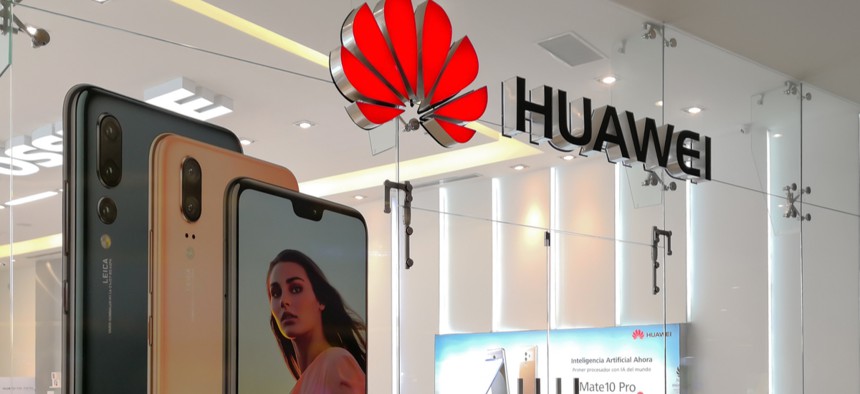Industry Wants to Know Exactly What Huawei Ban Means for Contractors

JHVEPhoto/Shutterstock.com
While the law is clear that agencies can’t buy tech from certain companies, it is ambiguous about how that affects federal contractors and grant programs.
Due to concerns of espionage and infiltration, federal agencies can no longer contract with companies that use technologies from two Chinese companies: Huawei and ZTE. But exactly how that ban will impact the federal contracting community is still up in the air.
A provision in the 2019 National Defense Authorization Act prevents agency heads from signing contracts “with an entity that uses any equipment, system, or service that uses covered telecommunications equipment or services as a substantial or essential component of any system, or as critical technology as part of any system.”
As federal agencies grapple with how to meet this directive, the Defense Department, General Services Administration and NASA held a forum Friday to hear from industry stakeholders and allow members of the Federal Acquisition Regulatory Council to ask questions.
Comments varied from nonplused to strongly concerned over how the legislation will affect ongoing federal business, including federal grants used for local public safety improvements. Despite differences in perspective, all speakers agreed on one thing: The current language is ambiguous.
While the first provision of the law clearly prohibits federal agencies from buying technologies from the covered companies, the second provision—on doing business with entities that use the equipment, quoted above—is less clear. Stakeholders at Friday’s forum urged the FAR Council to outline, in plain terms, how extensive this ban will be and how it will be enforced.
“There needs to be some kind of clarification in the FAR that puts this into the context of” direct performance of federal contracts, said Jake Parker, senior director of government relations for the Security Industry Association.
For instance, if a construction company uses Huawei equipment as part of their internal security system, should that company be prevented from winning federal contracts?
According to Parker, some 20% of small- and medium-sized businesses use technologies from one of the video surveillance companies named in the legislation.
These technologies are also being used in communities across the U.S. in places like schools, which use federal grants to buy and install video surveillance systems, Rick Williams, owner of Selcom, pointed out. Under the current language, it is unclear whether that grant funding could continue.
“We’re happy to stay within the law,” he said, but it is too broad as written. “We just need it to be narrower so that we can abide by it.”
A GSA spokesperson told Nextgov the council will take these comments and those from future feedback efforts into account when drafting a regulatory rule to take effect before the law’s August 2020 deadline.
The Case For Huawei
Debra Aron, vice president in the competition practice at Charles River Associates, offered analysis showing a delay in 5G development could cost the U.S. between $104 billion and $241 billion in lost gross domestic product, depending on how much longer it takes for the technology to roll out without Huawei’s involvement.
“Huawei’s 5G … equipment is the most advanced in the world and its absence will affect the quality of service in the U.S.,” she said, adding that the company’s antennae system is the most widely used in the world.
Prohibiting the use of Huawei technologies could delay 5G adoption by six to 18 months, Aron said.
Restricting the sales of Huawei technology is also causing a spike in prices for radio access network, or RAN, equipment, Aron said, pegging prices at 12% to 14% than if Huawei was able to fully compete.
Competition in this space is already limited, she pointed out, as only five companies have sufficient research and development efforts in place: Huawei, ZTE, Ericsson, Nokia and Samsung. Of those, Huawei is far and above the leader, she said, with more R&D efforts in the works than Samsung and Ericsson combined.
Thomas Goldberg, of Honeycomb Secure Systems, said the added costs can be offset through efficiencies in U.S.-based companies’ technologies.
“When we look at the hardship question … there is none,” he told the council. “In part because even if we do a comparison on a component by component basis, where our components cost twice—at a minimum twice—that of any other component available, the operating capacity of our system is so great that the actual cost of our system to the government—blade for blade—is 50 percent lower.”
Looking at the issue from this perspective, Goldberg argued the question of added costs should be considered from a total capability standpoint, rather than just the cost of individual components, such as those sold by Huawei and ZTE.
James Gauch, an attorney at Jones Day, agreed, suggesting the government should take a risk-based approach rather than being focused on individual vendors. Supply chain risks are ever-present in an interconnected global marketplace and not limited to a single vendor or technology, he said.
“Excluding several vendors based only on national origin will not address those risks,” Gauch said.
Editor’s Note: This story has been updated to clarify remarks from one of the presenters at the forum.



